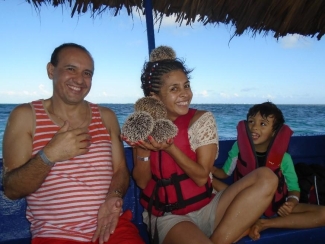For this installment of “Meet the Researcher” we caught up with Dr. Alan Lazarus a research scientist and immunologist at Canadian Blood Services’ Centre for Innovation.
How long have you been at Canadian Blood Services?
I've been working with the blood service in Canada since 1994.
What’s your role?
As a Canadian Blood Services scientist, my role is to lead research studies that further our understanding of how therapeutic immunoglobulin products like intravenous immunoglobulin (IVIg) and anti-D work in situations in which they are used. As an example, IVIg is a very expensive biologic made from the plasma of thousands of blood donors and it is used to treat patients with a variety of autoimmune diseases or inflammatory states. Although IVIg is a wonderful biological treatment for patients, we still have a poor understanding of how it actually works in the body. One of my goals is to understand how IVIg works so we can design a synthetic IVIg substitute that could be used in patients. We have already created a few synthetic substitutes for IVIg used to treat mice with autoimmune disease and the next step is to transition this work to treating patients.
Dr. Lazarus’ work has helped advance understanding of how IVIg works to treat certain diseases. In 2006, he was the senior author of a study published in “Nature Medicine”, which demonstrated that IVIg’s beneficial effect in treating the auto-immune disease Immune Thrombocytopenia (or ITP) appears to involve the interaction of IVIg with an activating receptor (called FcyR) on immune cells. This had not been previously reported, and was an important step in laying the foundation for subsequent scientific investigation into the effects of IVIg.
Where is your lab?
My lab is located at the Keenan Research Centre for Biomedical Science at St. Michael’s Hospital in Toronto.
Tell us about your area(s) of research...
I have two major areas of research. The first area is in IVIg replacements in murine models of autoimmune disease. The second area is trying to understand how anti-D works to prevent hemolytic disease of the fetus and newborn in a murine model. In both cases we are attempting to derive a synthetic replacement for IVIg and anti-D. IVIg and anti-D are made by pooling large numbers of blood donations together to make a final product. While IVIg and anti-D are both considered safe, we want to make synthetic substitutes rather than treat patients with pooled plasma products. Although there are a variety of reasons why this is important, currently Canada only collects enough plasma to treat roughly 30% of patients with IVIg. The remainder of the IVIg must be purchased on the open market in competition with other countries. If we did not have access to the IVIg on the open market, then most patients would go without. We wish to avoid this and therefore we continue to perform work towards finding IVIg and anti-D substitutes.
Learn more about immune globulins and hemolytic disease of the fetus and newborn in our Clinical Guide to Transfusion on our Professional Education website.
What are you working on now?
We have recently made a cool discovery in our mouse models. One of the treatments for a particular type of autoimmune disease called immune thrombocytopenia (ITP) is the use of anti-D. Anti-D is supplied by Canadian Blood Services for the treatment of ITP as well as the prevention of hemolytic disease of the fetus and newborn. It is not known to be beneficial in any other diseases. Based on some interesting results we hypothesized that anti-D may in fact be beneficial in other mouse models of autoimmunity or inflammatory diseases. We therefore tested this and surprisingly discovered that anti-D works in mouse models of inflammatory arthritis and transfusion-related acute lung injury (TRALI). TRALI, although very rare, is a leading cause of death in those receiving blood product transfusions. Therefore, the knowledge that anti-D could be used to treat TRALI as well as autoimmune diseases other than ITP is good news for patients.
Learn about Dr. Lazarus’ use of IVIg to prevent TRALI in the ResearchUnit: “Research into TRALI therapies generates results that are a TAD interesting!”
Why did you get into science?
Way back in the old days I was thinking of going into either science or engineering. Since my math skills were not the greatest I thought, let’s give science (biology) a try. It was a great decision and I have never looked back.
What inspires you?
The scientific process is what inspires me most in my job. I think it’s amazing that even though we might make mistakes in science and biology (I think we at first get most things wrong), with time and the desire of most scientists to try to disprove dogma, we eventually get it right.
What do you find most exciting about your work?
The possibility that something we create in the laboratory and test in mice may one day make it to patient care.
What work are you most proud of?
I am proud of many things that come out of our laboratory and the people who perform the actual experiments. I don’t think I can pick just one or two things.
Read more about the newest postdoctoral fellow to join the Lazarus lab in R.E.D.
When you’re not in the lab where could we find you?
Probably in traffic… but occassionally on a bog in Ireland.

Subscribe to our Research & Education Round Up to stay up to date on research publications and funding opportunities.
Visit our Funded Research Projects to view projects funded by Canadian Blood Services.
Canadian Blood Services – Driving world-class innovation
Through discovery, development and applied research, Canadian Blood Services drives world-class innovation in blood transfusion, cellular therapy and transplantation—bringing clarity and insight to an increasingly complex healthcare future. Our dedicated research team and extended network of partners engage in exploratory and applied research to create new knowledge, inform and enhance best practices, contribute to the development of new services and technologies, and build capacity through training and collaboration. Find out more about our research impact.
The opinions reflected in this post are those of the author and do not necessarily reflect the opinions of Canadian Blood Services nor do they reflect the views of Health Canada or any other funding agency.
Related blog posts
This week, we catch up with Dr. Sandra Ramirez-Arcos, Canadian Blood Services’ development scientist and head of the microbiology laboratory in Ottawa. How long have you been with Canadian Blood Services? I started working at Canadian Blood Services on November 10, 2003, so it will be 15 years in...
